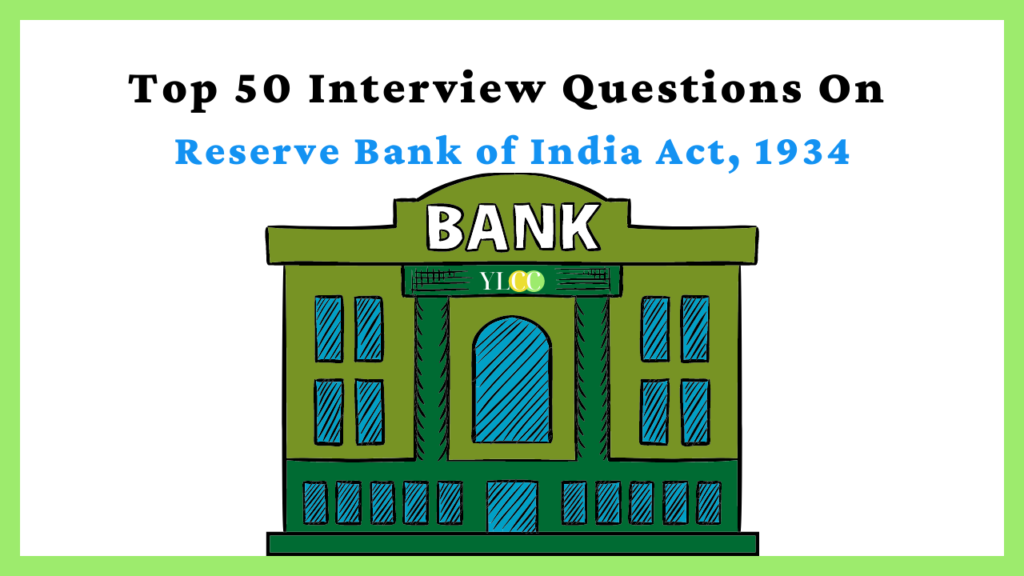
INTRODUCTION
The Reserve Bank of India (“RBI”) was established in 1926, when the Royal Commission (also known as Hilton-Young Commission) on Indian Currency and Finance, suggested the establishment of a central bank to separate the government from currency and credit management, as well as to boost banking facilities across India.
In the past, the Central Bank’s functions were handled by the Imperial Bank of India from the State Bank of India (SBI). Under the Reserve Bank (Transfer of Public Ownership) Act 1948, the Bank was a shareholders’ bank and taken over by the State, paid-up capital was Rs.5 crore. Mumbai is the RBI’s headquarters.
With the Reserve Bank of India Act of 1934 (“Act”), the RBI was established as the banker of the central government, and in 1935 their operations began. Throughout the years, RBI’s role and functions have been continuously revised to meet the needs of a changing Indian economy.
A crucial role of the Reserve Bank is to ensure the stability of interest rates and exchange rates, to provide liquidity for the real sector, to promote and develop financial institutions, to maintain the stability of the financial system through macro-financial monitoring. Indians depend on its decisions for their daily lives and it helps chart the country’s present and future economic and financial course.
In this article, Team YLCC brings you the Top 50 Interview Questions on the Reserve Bank of India Act, 1934. Read on!
TOP 50 INTERVIEW QUESTIONS
You must be well informed about the organization you are hoping to work for. As such, you should learn about the history and organizational structure of the RBI and its departments, functions, etc. Documents available on the RBI’s website are the most reliable source of information on this.
It is also important that you keep yourself up-to-date on the latest developments in the world economy and finance as well as in India. Furthermore, you need to stay up to date on recent trends and issues in the banking sector.
Prior to the interview, you must submit a bio-data form in which you should include your academic details, work experience, hobbies and interests, high academic and professional qualifications, prize/ medal/ scholarship details, and extracurricular involvement.
However, keep in mind that the panel may ask you very typical questions, but unexpected, regarding your hobby/academic/professional qualifications. Thus, prepare for these questions in advance. Because the bio-data questionnaire is all about you, you will be in a position to confidently answer all questions.
The following are set of important questions related to the Act:
1. What is the enforcement date of the Act?
2. Under which section, the functions and the constitution of the Local Boards are covered?
3. Under which section does RBI have the right to transact Government business in India?
4. What is section 18 of the Act?
5. What do you mean by “average daily balance” as defined under section 42 of the Act?
6. What are the functions of the RBI under section 17 of the Act?
7. How and why is the RBI considered as the banker’s bank?
8. What are “commercial banks” according to the Act?
9. How are “securities” been defined under the Act?
10. When the RBI did was put under entry 38 List I, VII Schedule under Article 226 of the Indian Constitution?
11. Is the scheduled bank required to send a return to the RBI?
12. Can RBI provide emergency loans to banks on liberal terms?
13. Is a banknote exempted from the stamp duty?
14. Can the RBI add or delete the name of any bank in 2nd schedule of the Act?
15. What are the several models of Central Banking?
16. What are ordinary commercial banking functions?
17. Who is the present RBI Governor?
18. Can RBI re-issue notes?
19. Is the special one rupee note be deemed to be included in the expression “rupee coin”?
20. Do section 10 of the Act covers disqualifications of Directors and members of Local Boards?
21. Who acts as the RBI’s representative in locations where the bank does not have its own office?
22. Do RBI act as a banker to the Government?
23. What is Reverse Repo Rate?
24. What are the powers and duties of the auditors?
25. What are the assets of the Issue Department?
26. What is the aggregate value of the gold coin, gold bullion and foreign securities held as assets under the Act?
27. When are the deposits not to be accepted as stated under the Act?
28. What are the liabilities of the Issue Department, as defined under the Act?
29. When did the RBI publish the proposed regulations for the Credit Information Companies (Regulation) Act, 2005?
30. When did the draft guidelines for establishing a grievance redressal process within NBFCs (Non-Banking Financial Companies) become available?
31. When did the Centre pay over Rs 35,531 crore in New Delhi for the Reserve Bank of India’s whole 59.73 per cent equity stake in the State Bank of India (SBI)?
32. Which guidelines/rules did the government use to pick up all of the SBI shares held by the RBI?
33. Within how many days should the failed ATM transaction be resolved?
34. What are the requirements of the meetings of the Central Board?
35. Do Central Board has the power to make regulations?
36. What are the exemptions granted to RBI under sections 48 and 57 of the Act?
37. Brief overview of V.T. Khanzode Vs. Reserve Bank (AIR 1982 SC 917).
38. When the RBI did introduce ‘no frills’ accounts?
39. What are the main functions of the Assets Reconstruction Company?
40. The RBI may issue banknotes with a maximum denomination of? (As per Section 24 of the Act)
41. RBI has directed all the banks to ensure that the names of their customers, individuals or corporate, do not appear in any list published by the Security Council Committee. What does the RBI want to ensure with this directive?
42. As per newspaper reports, inflation in India and China was at a very high level. Under such circumstances, what does the Central Banks of these countries are required to follow?
43. How can the RBI exercise credit controls?
44. How is the RBI responsible for maintaining the external value of Indian currency?
45. Brief about the organisation chart of RBI under sections 8 and 9 of the Act.
46. What are the obligations of the Government and the RBI in respect of the rupee coin?
47. What are the exceptions provided regarding the disclosure of information under section 45E of the Act?
48. What are the powers of the RBI concerning determining policy and issue directions under section 45JA of the Act?
49. When the transactions in the derivatives are considered to be valid?
50. What are the members constituting the Joint Committee as stated under section 45Y of the Act?
YLCC would like to thank Nikunj Arora for his valuable contribution in this article.







